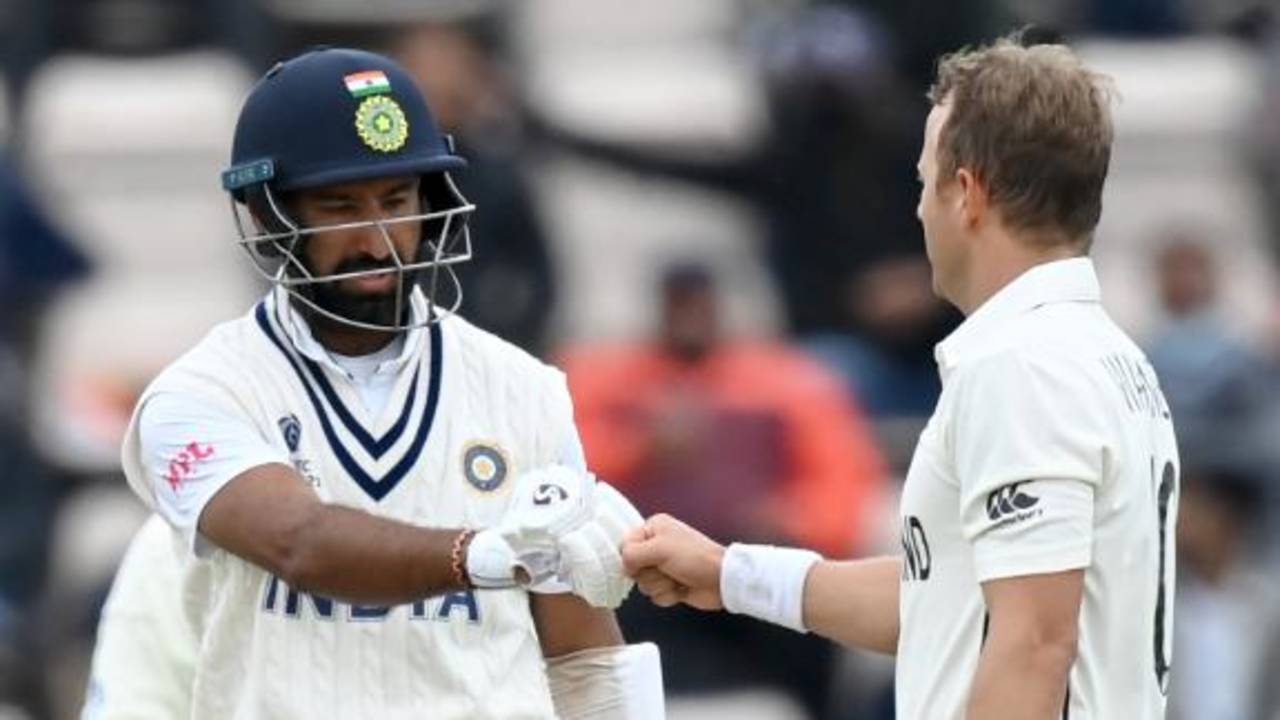Patience and restraint, the new arrows in Virat Kohli's quiver
The India captain has left nearly 34% of his 124 balls so far - a vastly different approach than what we are used to
Nagraj Gollapudi
19-Jun-2021
Third ball of the 11th over after lunch on the second day of the WTC final, Virat Kohli moves back and across as soon as Neil Wagner bangs it in short, headed outside off stump. Standing up on his toes, Kohli flashes hard, and is beaten for pace by the 82mph delivery. Bowler and batter stare at each other, exchanging only smiles, no words.
Only 16 runs had come from 11 overs in the second session at that stage, which featured half a dozen maidens. Just before the break, India had managed seven runs in eight overs of which five were maidens. That dry phase had started with the fall of Rohit Sharma, followed a few overs later by that of Shubman Gill.
Kohli's response to the short, wide-angled delivery from Wagner was instinctive. Yet, it was an uncharacteristic reaction in what was a masterful display of restraint, which allowed India to get their teeth into a tough job.
Watch cricket on ESPN+
Despite opening for the first time in England, Sharma and Gill showed exuberance in going for runs, which came at a decent clip especially in the first ten overs, as New Zealand's new-ball bowlers struggled for consistency. But, as soon as the two fell, New Zealand became more disciplined. That made the second session crucial. In any case, overcast conditions, inclement weather, and two outstanding bowling attacks had suggested a low-scoring match, and anything around the 250-mark might be good enough.
That was evident in the batters' approach. Cheteshwar Pujara had played 21 balls without making a run before lunch. The first over of the second session, delivered by Wagner, was a maiden. Kohli was the batter. Kane Williamson threw the ball to Colin de Grandhomme.
In their one-on-one duel during the two-Test series in New Zealand last February, de Grandhomme had conceded just one run and sent Kohli back once in ten balls.

Virat Kohli got off the mark with a classy drive through the covers•ICC/Getty Images
He might be just a medium-pacer, but de Grandhomme's strength is that he can sneak the ball past the outside edge or rap the pads with seam movement both ways. Immediately into his spell, de Grandhomme got the perfect length: not full enough, but on a spot where the batter might consider the drive. Kohli was beaten by one such delivery early on, one that pitched on middle-and-off, and moved just enough to beat the edge and hit the outside of his back leg. BJ Watling took the catch but there was no bat involved, and Hawk-Eye showed it to be clearing off stump.
Kohli managed just four runs from the 21 deliveries he faced from de Grandhomme. In the first Test of the 2018 series against England at Edgbaston, Kohli had faced 27 deliveries off James Anderson without scoring a run. He ended up scoring a century, one of his best.
On this day, New Zealand had a short cover and short midwicket for Kohli, but Williamson had left big gaps on both sides for the India captain to pick. Kohli abstained. Standing, typically, a good yard outside the popping crease, he negotiated both the swing and the seam movement, mostly with ease. His other strength, taking a big stride forward, came in handy, too, as he played the ball under his eye line. Firmly.
There was another change that Sunil Gavaskar, among others on commentary, found in Kohli's technique that should help him: as and when Kohli makes a back-and-across movement, he keeps the front leg straight, which allows him to deal with the incoming delivery much more efficiently, nullifying the threat of being lbw. There was also the open stance, which allowed Kohli to not just read the line of the delivery better, but also deal with it more effectively.
These technical changes allowed Kohli to score runs against the swing, too, mainly square of the wicket. As per ESPNcricinfo's logs, he scored 25 of his 44 runs in the area between cover and backward point.
But what shone through brighter than all of this was Kohli's patience. As he rushed out with Cheteshwar Pujara after the lunch break, he reminded one of a boxer getting inside the ring. The keenness. But, once he took guard, Kohli was Zen-like. He left a lot of deliveries: nearly 34% of his 124 balls so far. Before tea, Kohli was not in control of only nine out of the 96 balls he had faced, and then seven out of the 30 in the truncated third session.
Kohli showed that he could, when needed, be quiet. Along with Pujara and then Ajinkya Rahane, he ensured India would not lose the edge earned through hard work, in the second session. If he can show the same powers of concentration over the rest of the weekend, Kohli might, yet, play the defining role in this WTC final.
Nagraj Gollapudi is news editor at ESPNcricinfo
